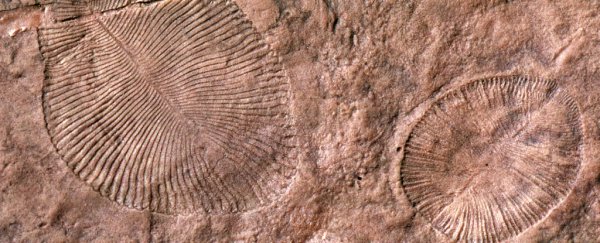How animals evolved on Earth is somewhat murky. We know that most major animal phyla we see today appeared during the Cambrian explosion 541 million years ago - but before that, the fossil record is patchy.
But that doesn't mean it's nonexistent. Before the Cambrian explosion, there lived a group of strange lifeforms known collectively as the Ediacaran biota. But exactly what those lifeforms were and how they fit in with the tree of life has long remained a mystery. Now, we might finally have some answers.
A team of researchers from Cambridge, Oxford, Bristol, and the British Geological Survey has confirmed that one of the strangest and most iconic of the Ediacaran biota, a creature known as Dickinsonia, was officially an animal.
That suggests animals were around before the Cambrian explosion.
"'Dickinsonia belongs to the Ediacaran biota - a collection of mostly soft-bodied organisms that lived in the global oceans between roughly 580 and 540 million years ago," said lead researcher Renee Hoekzema of Oxford.
"They are mysterious because despite there being around 200 different species, very few of them resemble any living or extinct organism, and therefore what they were, and how they relate to modern organisms, has been a long-standing palaeontological mystery."
The Ediacaran biota is so puzzling because there's nothing else like them.
Initially, the Ediacaran biota were thought to be complex multicellular animals, or metazoans, and a growing body of research is returning to that idea.
But they're not easy to tie down, with algae, protozoans, lichens, and colonies of bacteria all being floated as possibilities at various times.
But none of these explanations have ever fully fit, because of how strange the creatures were - particularly Dickinsonia, which looks strangely like a ribbed oval.
Dickinsonia was first described in 1947, at which time it was categorised as a jellyfish. It has also been thought to be a worm, a polyp, or even a mushroom.
It has so few features in common with modern organisms that the approach to categorising has mostly been throwing ideas at the wall to see what sticks.
This new classification of it as an animal is based on how the creature grows.
"We took the approach of looking at populations of this organism, including assumed juvenile and adult individuals, to assess how it grew and to try to work out how to classify it from a developmental perspective," said researcher Alex Liu from Cambridge.
As you can see in the image above, Dickinsonia's body is divided into segments. The researchers counted and measured these segments, and plotted them against the age of the organism to create a computer model that could replicate how the creature grew as it aged.
However, the team did not assume that one end was the 'head' and the other the 'tail', as previous teams have done, instead running the simulation first as if one end were the head, then as if the other were.
What they found was that researchers have had the creature the wrong way around for decades. This isn't the first time this has happened. Just two years ago, researchers discovered that another Precambrian fossil, the iconic Hallucigenia, had been studied back-to-front for decades.
"When we combined this growth data with previously obtained information on how Dickinsonia moved, as well as some of its morphological features, we were able to reject all non-animal possibilities for its original biological affinity and show that it was an early animal, belonging to either the Placozoa or the Eumetazoa," Hoekzema said.
Placazoa are among the simplest of animal organisms, and Eumetazoa are a step up from sponges. Figuring out which Dickinsonia belonged to could be the next mystery to be solved.
Importantly, the research also contributes to the body of evidence that suggests animals were actually around tens of millions of years before the Cambrian explosion.
"It also allows Dickinsonia to be considered in debates surrounding the evolution and development of key animal traits such as bilateral symmetry, segmentation and the development of body axes, which will ultimately improve our knowledge of how the earliest animals made the transition from simple forms to the diverse range of body plans we see today," Liu said.
The research has been published in the journal Proceedings of the Royal Society B.
